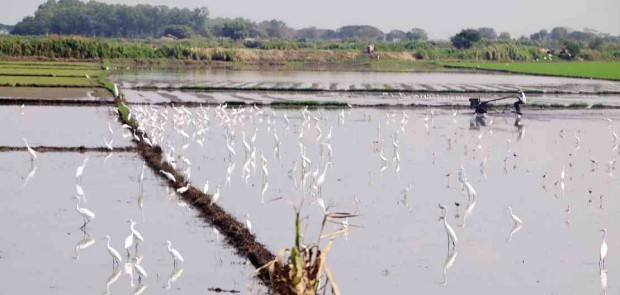Environment group told: Buy land, save birds

LOCAL and migratory birds take refuge from cold and winter in water-fed farms and flood basins in Candaba town in Pampanga province from October to March. But they have been losing their habitats as people turn these areas into rice land and fishponds. E. I. REYMOND T. OREJAS/CONTRIBUTOR
CANDABA, Pampanga—Buy the land to preserve migratory birds and their habitat.
The Philippine Wilderness Land Trust (PWLT) and the Manuel V. Pangilinan-led Metro Pacific Tollways Corp. (MPTC) are taking this innovative step to preserve the last sanctuary of local and migratory birds in the 35,000-hectare Candaba Swamp.
PWLT and MPTC officials visited Sitio Doña Simang in Barangay Vizal San Pablo here on Saturday to inspect a 70-hectare lot where globe-trotting birds as well as domestic fowls have been landing for the last 20 years to escape the Siberian winter and local cold fronts.
They were accompanied by bird watchers and bikers, who have advocated for the protection of this valuable bird habitat.
Candaba Swamp is one of five wetlands in Central Luzon. The others are the Paitan Lake in Cuyapo and Pantabangan Dam, both in Nueva Ecija; Puerto Rivas in Balanga City; and Consuelo in Macabebe, also in Pampanga.
Article continues after this advertisementThe property which PWLT and MPTC inspected belongs to Jerry Pelayo, a former mayor of Candaba.
Article continues after this advertisementHe bought the land from a bank in the 1990s, but Pelayo did not disturb a large pond there when he realized it had been frequented by six or seven dumara (Philippine wild ducks).
“In my childhood, dumara darkened the skies when they flew. They were too many back then,” he informed his guests.
Bird sanctuary
In the last eight years, birds of all kinds and sizes came by the thousands to three other ponds inside Pelayo’s property, some even nesting in the area.
But sustaining a bird sanctuary was difficult, said Pelayo. “I did not get any centavo from the government. I did not collect any fee from visitors either,” he said.
Pelayo said he spent a P1-million grant from the German government to construct a viewing deck and the fences surrounding the ponds.
To pay for the medical expenses of his wife, Pelayo grew rice on a portion of his property, preserving 28 hectares for the birds. This did not please bird watchers, however.
“They forget this is my land. I need to balance the needs of my family and the birds,” Pelayo said, prompting him to seek the support of environmentalists like PWLT president Ivan Sarenas.
Sarenas said, “We plan to acquire and preserve [Pelayo’s property] as a wilderness forever… We can’t just complain to the government or wage campaigns on Facebook. Ownership of the habitat is a way of protecting it and the birds.”
Sarenas described this part of the Candaba Swamp as an internationally important wetland.
Funding conservation
“We are amenable to being part of a group that will fund conservation,” said Rodrigo Franco, MPTC president and chief executive officer, although he said the price of the purchase has not yet been discussed.
“We need to craft a business model for the place,” Franco said. “One thing we can assure [conservationists] is that [the MPTC and Manila North Tollways Corp.] are willing to be the cornerstones of the group.”
In January 2013, 5,475 waterfowls of 31 resident and globe-trotting species were recorded in two sites here for the Asian Waterbird Census by the Department of Environment and Natural Resources and the Wild Bird Club of the Philippines (WBCP).
The 2013 figure was less than the 12,600 birds tallied in 2012, and the 8,600 birds counted in 2011, according to records.
Alain Pascua photographed a dusky warbler at the Doña Simang site in Barangay Vizal San Pablo. Mike Lu, president of WBCP, said this was the second sighting of this species in the Philippines.
The common shelduck was first seen in Candaba this season, Lu said.
The 2013 census identified 14 migratory species including little egrets, intermediate egrets, great egrets, gray heron, common teal, northern shoveler, tufted duck, common kingfishers, common sandpiper, wood sandpiper, northern pintail, garganey, whiskered tern and the eagle-like eastern marsh harrier.